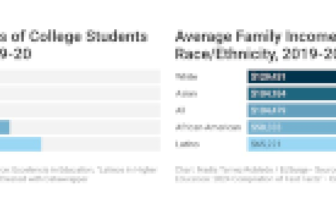How the Invisible Tax of Being an Educator of Color Pushed Me Out of the Classroom

[ad_1]
During my first years of teaching, I decided that no matter how difficult life got, both in and out of the classroom, I would never leave my class in the middle of the year.
For years, my co-teachers would come and go from our grade level, and all I felt was adversity towards them: I mean, how could they leave in the middle of the year without considering the impact on our students? Time and time again, I felt rage and disgust with educators who quit simply because it was too much.
This past December, six years into my teaching career, I was the one packing up my classroom.
Truth be told, I thought I was made of steel. My Latinidad felt like armor that shrouded me and provided comfort on my toughest days; my early childhood traumas served as my “why” and kept me from acting on impulse and leaving. What I failed to realize, however, was that no matter what I did, the invisible tax, a term that refers to the unseen burdens placed on individuals due to their race, ethnicity and gender, was always a few doors down — lingering, waiting for me to slip up to sway me from my passion.
I taught at the preschool level for about three years and eventually made my way to elementary where I stayed for an additional four years. Then, I was placed in a school where I had previously taught, which was in the center of my hometown and in an underrepresented neighborhood. My teacher preparation program forced me into a school where I was not prepared to teach, stripping me of the comfort of second grade and thrusting me into the realm of middle school.
While some educators would rally at the thought of being back home and working in their former schools, those of us who have experienced adversity within our respective communities quiver at the thought of being back. As any educator could imagine, things went south right away.
Utilizing Trauma to Establish Meaningful Connections
My first few days teaching seventh grade history were nothing short of a disaster. The entire seventh-grade team consisted of long-term substitutes, and the administrators were all pulled into the classroom to fill the teacher shortage at our school. This left children to act and run their classes as they saw fit, and few teachers truly felt well-equipped to teach on a daily basis. As a result, those of us who did not sink were forced to keep our respective grades afloat. However, the school was not to blame for the chaos that ensued daily. How could they control a teacher shortage that was affecting the global population? Still, in our time of need, teachers were forced to hold themselves up and put their best foot forward, even if they were alone in doing so.
To survive, I leaned on my past experiences to keep me grounded in my work and convinced myself that as a Latino who made it in life, it was my moral obligation to save the children from failing. Where everyone else saw a troublemaker, I saw a child seeking attention from a trusted adult. When a student would yell at me for holding them to a high standard, I felt their insecurity and met them with reassurance that no matter the circumstance, they had a strong team of educators to support them.
In the most intense moments, when my safety was compromised, it was daunting to maintain focus on the students’ well-being when my own mental health was taking a toll. Even then, I relied heavily on my adverse experiences to remind me that it was on me to prevent the children from experiencing the same thing. What I failed to learn early on was that utilizing a darker part of my identity to lead my teaching practice would work to my detriment.
The Price of Re-Traumatization
I thought I was connecting with my students because we were forming meaningful connections. However, anytime a student experienced or shared an experience related to my own trauma, I relived my own and reverted to the fixed mindset I had at their age.
In this state of mind, I, too, thought that the world was working to hurt me and that my life would be a never-ending loop of pain and injustice. I was no longer their teacher; at that moment, I had transformed into their adolescent peer who was weighed down by the looming threat to safety I often experienced at their age. I couldn’t be a safety net for them and also bring myself out of the void of darkness I had fought to overcome.
I knew my students were and continue to be more than their trauma. After all, if I could experience adversity and trauma all through my childhood and still graduate from college, move out on my own and become a licensed teacher — couldn’t the same be true for my students? At the end of the day, however, I believed my students needed an educator who could keep them grounded and help them cope, and frankly, I was not strong enough to take on that responsibility.
After two years of witnessing traumatic experiences and hearing of injustices within my community, I decided that for my own mental health, I had to transition out. I had finally understood why educators, who I looked up to and whom I cherished and appreciated, chose to leave. It wasn’t solely because the job was difficult or draining — it was because we should not have to relive our most traumatic experiences for the sake of being a strong educator of color. We cannot allow ourselves to fall into the idea that because we are part of the few who succeeded despite the odds we must then provide the same level of support for children of color who need us.
Finding Better Ways to Cope and Heal
Rather than task educators of color with being a savior that children can relate to, administrators and policymakers need to consider alternative options, including, but certainly not limited to:
- Providing trauma-informed training for all staff interacting with children. California, for example, provides free, self-paced training for anyone working with children;
- Utilizing students’ and families’ funds of knowledge and acknowledging that they are people before they are students; and
- Recognizing that trauma, at any level, needs to be handled with care and delicacy, and extends to children and adults alike.
Reflecting on my journey, it’s clear that the decision to leave wasn’t made lightly. It came from a place of deep, personal reflection and understanding and a realization that as educators, especially those of us who share traumatic and adverse backgrounds like our students, we carry an emotional burden that is often invisible and heavy. My experience has taught me that while our intentions to connect and uplift are noble, they can also lead us to confront our own unresolved traumas in ways that are not always healthy or sustainable.
This journey has underscored the importance of creating supportive environments not just for our students but for teachers as well. It’s not about asking educators of color to shoulder the responsibility of being both teacher and savior. Instead, we need systems in place that recognize the unique challenges we face and provide the necessary support to navigate them. Our health cannot be the price we pay in exchange for empowering young minds.
As I step away from the classroom, my hope is that my story will serve as a call to action. It’s a reminder that our work as educators goes beyond the academic; it’s about nurturing and protecting the well-being of every member of the school community, including ourselves. By acknowledging the complex realities of our students and educators, especially those from marginalized communities, we can begin to foster an environment where everyone has the opportunity to thrive without sacrificing their mental health or well-being.
[ad_2]
Source link







